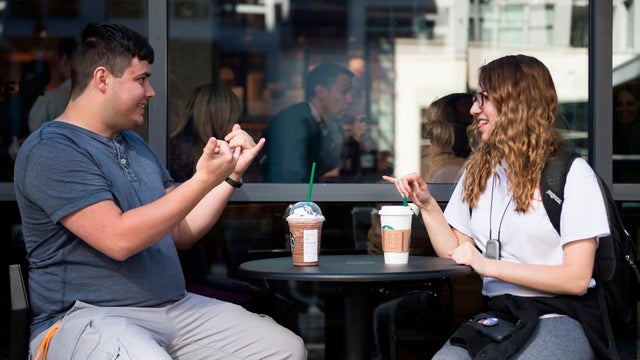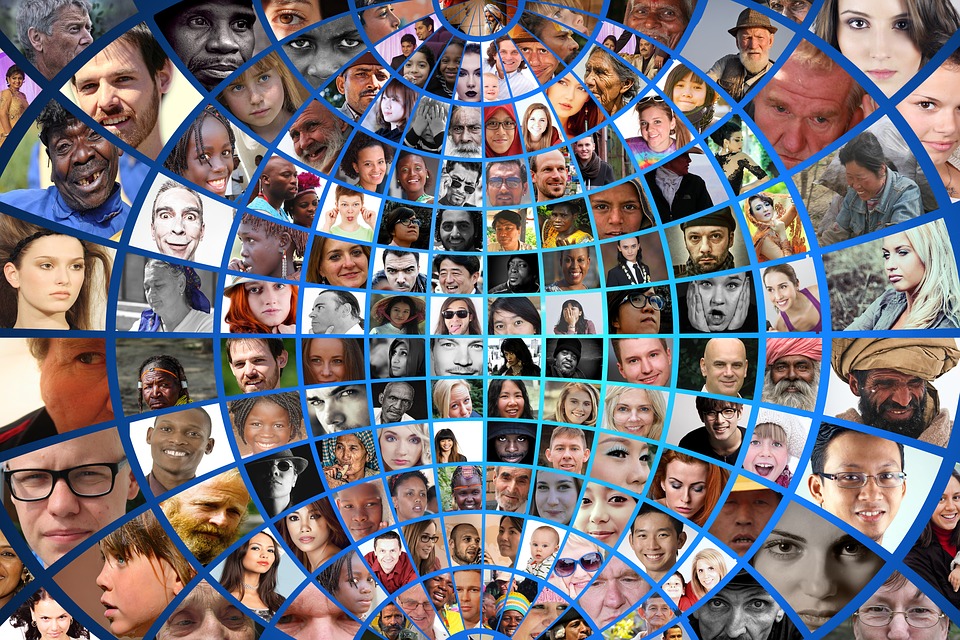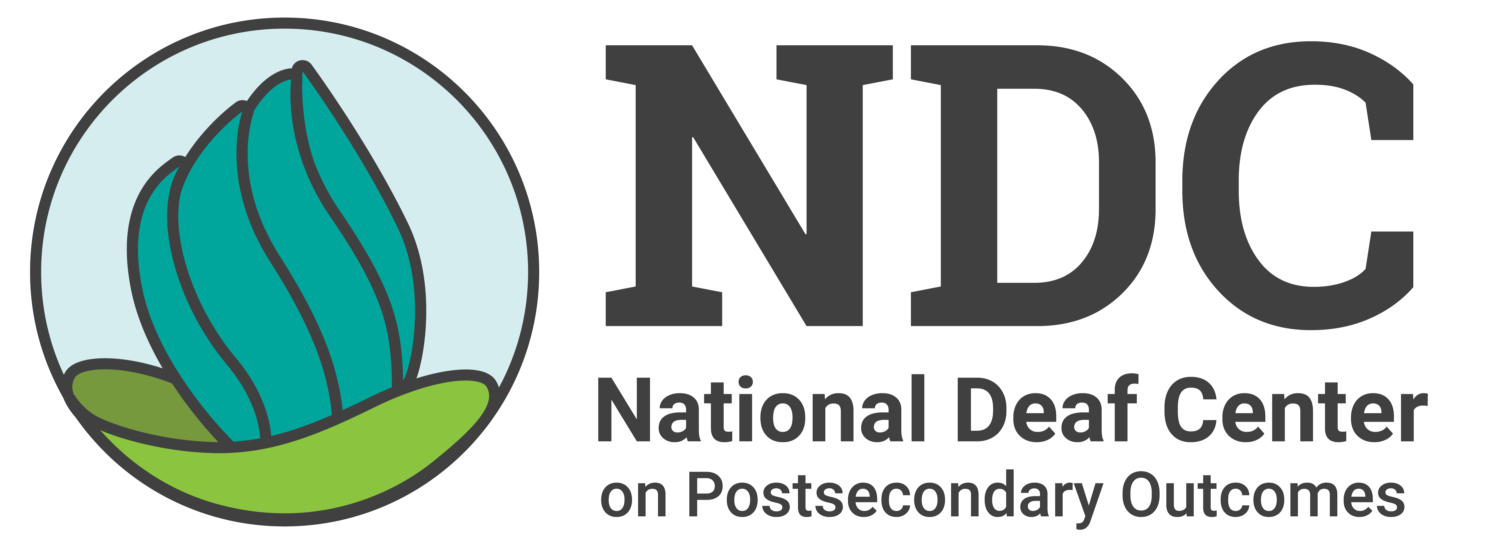While deaf people share certain experiences, the community is made up of a wide range of deaf people. Some consider themselves to be part of the unique cultural and linguistic minority who use sign language as their primary language, while others do not. Deaf people have a wide range of communication preferences, cultural and ethnic backgrounds, and additional disabilities that shape their interactions with their environment.
Defining Deaf
What do we mean when we say "deaf"?
The National Deaf Center is using the term deaf in an all-inclusive manner, to include people who may identify as deaf, deafblind, deafdisabled, hard of hearing, late-deafened, and hearing impaired. NDC recognizes that for many individuals, identity is fluid and can change over time or with setting. NDC has chosen to use one term, deaf, with the goal of recognizing experiences that are shared by all members from multiple communities while also honoring all of our differences.
What is American Sign Language?
Sign languages are complex, natural languages, with their own grammar, vocabulary, and dialects. There is no universal sign language; countries and regions around the world have their own signed languages. While American Sign Language (ASL) is the most widely used sign language in the United States, other sign languages like Black American Sign Language (BASL) and Plains Indian Sign Language (PISL) reflect the rich linguistic variety within deaf communities.
The National Association of the Deaf explains that in ASL, “the shape, placement, and movement of the hands, as well as facial expressions and body movements, all play important parts in conveying information.” ASL is not a communication code that merely represents English. It is its own distinct language.
What Are Some Unique Features of Deaf Culture?
Values, behaviors, and traditions of deaf culture can include the following:
Environment
An emphasis on visual transmission of information. Architectural and interior designs often include excellent lighting, open floor plans, and spatial positioning of furniture that enhances visual sight lines.
Regional Language
Valuing the sign language of the region and supporting sign language use in educational settings, such as bilingual ASL/English programs in the United States.
Social Connections
.Maintaining cultural traditions through social activities including athletic events, deaf organizations, and school reunions
Community
A high degree of networking and deep connections within the deaf community.
Technology Use
Creative use of technology to resolve communication issues.
Art
Promoting deaf culture through art forms such as painting, drawing, film, folklore, literature, storytelling, and poetry.
Communicating with Deaf People
There are so many ways to be deaf, and so many ways that deaf people communicate, both with each other and with hearing people. While deaf people will always be the best source of information on how to effectively communicate with them in various situations, there are some general principles that can be helpful to keep in mind.
What is Some Terminology to Avoid?
Some common terms that are generally viewed as offensive within the deaf community include “hearing impaired,” “deaf-mute,” and “deaf and dumb.” These terms have some intrinsic problems, such as a deficit framing that assumes that deafness is negative, but also have contextual issues, where usage of those terms indicates that the user is unfamiliar with the deaf community. While, again, the deaf community is large and there are varied preferences within that community, it is generally best to avoid these terms.

Do All Deaf People Consider Themselves to be Culturally Deaf?
Though some deaf people fully embrace all aspects of deaf culture and community, others may identify only marginally or not at all. Identity is a highly personal process that is always evolving.
Deaf people may undergo changes in their beliefs and identity as they mature from childhood into adulthood, including how they self-identify in terms of their hearing loss. Some deaf people do not have significant exposure to deaf culture until adolescence or later, and might choose to become part of the deaf community at that time. For this and other reasons, a deaf person’s identity may change over the course of their lives.

Who is Part of The Deaf Community?
The deaf community includes people who identify as hard of hearing, late-deafened, deafblind, deafdisabled, and more. Some experiences are shared by all members of these diverse communities, while others are more unique.
Because of this wide range of experiences, it is important to avoid assumptions and to seek input from each individual deaf person.
Deaf with Disabilities: Transition & Postsecondary Education
Understanding the experiences of deaf people with disabilities is key to providing the right support. Research suggests that nearly half of deaf people have an additional disability, yet many are not reported due to barriers in healthcare, inaccessible assessments, or personal concerns about disclosure.
For colleges and training programs, this means taking a flexible, student-centered approach to accommodations and services. Click the link below to learn more about effective strategies for supporting deaf students with disabilities.
8 Strategies for Deaf Communities to Enact System Change
Decisions are made every day about deaf people’s lives without the involvement of deaf people. This needs to change. The lived experience and knowledge of deaf community members must guide policy changes, strategic planning, and programs that are designed to reduce barriers and increase opportunities for deaf people. Listening to community members, and letting them lead the way, is important.
Deaf Awareness Micro Certificate
The Deaf Awareness Micro Certificate is a free, self-paced, completely online program that encourages self-awareness and understanding of systems and attitudes experienced by deaf people. The Deaf Awareness Micro Certificate will allow you to explore lived experiences of deaf people and learn strategies to create accessible environments. Through self-reflection, you will be challenged to examine attitudes and assumptions about deaf people and apply methods to challenge and deconstruct them.
Online Learning Opportunities
We have wide range of free, self-paced modules that you can take, including:
Community Resources
There is a wealth of informative resources out there—including resources from local organizations! Our goal is always to bring you the most accurate and reliable information, and that includes connecting you with the information and organizations that can answer your questions and get you the support you need.





